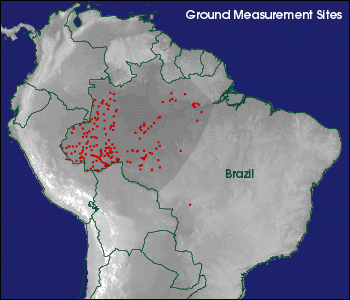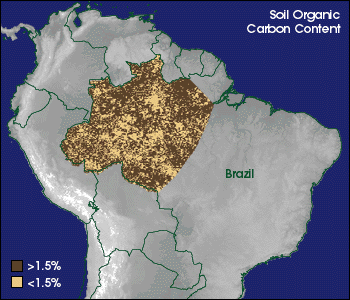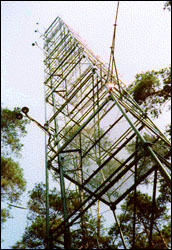| |
How to build better climate models |
|
 
|
Many Earth system scientists routinely use computer models in their
research. Yet they have generally moved beyond the creation of new models, and
are working to improve the existing ones. A model isn't finished until it
realistically portrays the system it is designed to simulate and accurately
predicts how that system will change in the future. The point is that, today,
Earth system science is less likely to result in totally new discoveries than it
is to gradually revise our understanding of our complex home planet through a
deliberate, iterative process (sort of like peeling an onion, one layer at a
time).
|
|
|
According to Levine, the sophistication of the model reflects the maturity of
the science. In the 1980s, when Levine was still a Ph.D. student at Penn State
University, she studied the effects of acid rain on soil using a simulation
model. Levine used existing soil profile information that described the
physical and chemical properties of the soil at various depths. She also used
climate information that described the amount and acidity of the precipitation
falling on the soil. Then she ran her simulation model to predict the changes
in soil chemistry over time, and to identify soils that would be sensitive to
acid rain inputs.
Levine found that certain soils are more sensitive to, while others are more
tolerant of, acid rain. She describes the sensitive ones as shallow, letting
water pass through quickly. Shallow soils typically don’t have much
capacity for holding nutrients and they don't contain much organic matter.
Conversely, soils that are more tolerant of acid rain are generally thicker,
more fertile, contain more organic matter, and filter water through more slowly.
In the shallow, sandy, and low buffering soils, Levine found that, over time, acid rain decreases
fertility, increases the acidity of the soil, and affects the biological contents
(bacteria, worms, etc.) of the soil.
When she came to NASA in 1987, Levine was asked to understand the soils of
the entire world. Her challenge: how to extrapolate from digging holes at
single sites to mapping the soils of the Earth? The most burning scientific
questions did not allow her to look at soils in isolation, but instead to
recognize the role soils play in the whole ecosystem. She began working with
scientists in other disciplines to identify links between each of the subsystems
of the natural environment. (Here, "subsystems" refers to all of the
small components within the natural environment that are contained within, and
comprise, the terrestrial ecosystem.)
|
This soil profile—an oxisol—is similar to
the soils found throughout the Amazon basin. Because directly measuring the organic carbon content
(by digging a pit) is a laborious process, scientists use models to extrapolate data. (Photograph courtesy National Soil Survey Center)
|

"It turns out,
the interfaces between Earth’s subsystems are where
most of the significant processes are happening," Levine observes.
"To understand things like the exchange of carbon dioxide between the soil
and the atmosphere, or the uptake of nutrients from the soil by plants, or the
return of nutrients through rain and litter back to the soil--to understand all
of these things requires us to examine the interfaces between Earth’s
subsystems."
|
The ground-based soil sampling sites shown
here (red dots), scattered throughout Brazil's Amazon Basin, can not provide
enough data to map the entire region. However, these data are used to "train"
computer models to recognize patterns in satellite imagery that relate to conditions
on the surface that can not otherwise be measured remotely. (Image by Steve Fifer, NASA Goddard Space Flight Center) |

Today, Levine is using her data-driven modeling approach to map soil and
vegetation types across Amazonia, South America. Her goal is to find out how
much carbon is stored in the soils there. Using data from 200 sites on the
ground in the Brazilian Amazon, Levine and her colleagues "trained" a
neural network using soil, land cover data, and satellite imagery.
(Levine’s model uses a program that can improve itself, or learn, by
comparing its predictions to real measurements and then revising its processing
algorithm. The process of preparing a given model to make certain types of
predictions is called "training the model," which in this case is
Levine’s neural network.) Levine then used the trained model to estimate
the amount of soil carbon present in the Amazon region based on satellite
imagery alone (Levine and Kimes 1998). Next she is planning to generate
soil-carbon maps for a larger portion of the Amazon region--a task that would
take many years to complete if she relied solely on ground-based
measurements.
The Leap from ‘Local’ to ‘Global’
According to Running, making the transition from small-scale to
global-scale models wasn’t easy for many terrestrial ecologists, who were
trained to study individual organisms. In the early 1980s, most vegetation
models were constructed for individual trees to show things like water and
carbon movement. But Running notes that the small-scale models helped
scientists identify the ecosystem processes that larger-scale ecosystem models
needed to incorporate--things like the carbon cycle, the processes of
respiration and photosynthesis, decomposition, canopy characteristics, soil
type, regional hydrological and nitrogen cycles, etc.
"In adopting a global perspective, we learned that we need to stop
worrying about each plant as an individual," Running explains. "In
producing remote sensing data products like the Normalized Difference Vegetation
Index (NDVI), we began to think more abstractly about the biosphere as a
‘chlorophyll sponge.’ Land surface cover became an aggregation of all
vegetation, not individual plants."
|
This map, derived from a model that combines data from ground
stations (top of page) with satellite imagery, shows soil organic carbon content where
it is difficult to obtain these measurements directly. (Image by Steve Fifer, NASA Goddard Space Flight Center) |
Running is quick to point out that global-scale modelers did not abandon the
strategy of direct measurements that got them here. Rather, most modelers use a
nested approach in which model results are compared to actual measurements (or
validation data) obtained at multiple sites around the globe. Running’s
team coordinated the establishment of a worldwide network of towers equipped to
measure a range of variables in the atmosphere (temperature, humidity,
precipitation, carbon dioxide levels, sunlight, etc.) and on the ground (canopy
types, carbon dioxide taken in and released during photosynthesis, foliage
produced, etc.). Called FLUXNET, the network of instrumented towers
automatically records data every five minutes. These data are stored and later
compared with satellite measurements, as well as model results.
It is the ongoing comparison of model results with real data that enables
scientists to continue refining their models toward a real predictive
capability. Already, climate models are showing promise that they will enable
scientists to forecast certain changes months or even years ahead of
occurrence.
 Can models show us the future? Can models show us the future?
 Why Build Computer Models? Why Build Computer Models?
|

FLUXNET towers are positioned all over the world -
including this measuring site at Brasschaat, Belgium. (Photograph courtesy
University of Antwerpen, Dept. of Biology, UIA, Wilrijk, Belgium
Prof. R. Ceulemans)
|

